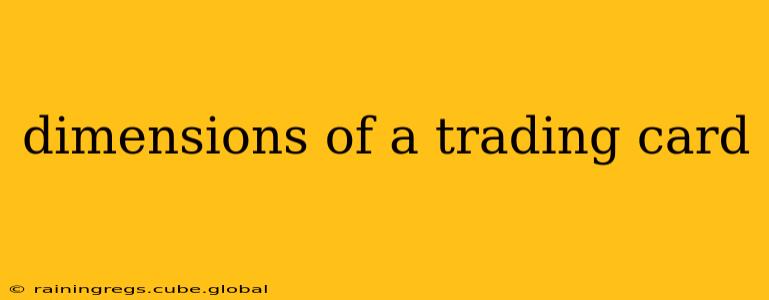Trading cards, those little pieces of cardboard that hold immense value for collectors and enthusiasts, come in a variety of sizes. While there isn't one single, universally accepted standard, certain dimensions are far more prevalent than others. Understanding these dimensions is crucial for collectors, designers, and anyone involved in the trading card industry. This guide delves into the common sizes, variations, and the reasons behind them.
What are the Standard Dimensions of a Trading Card?
The most common size for trading cards, especially in the United States and internationally for many popular card games, is 2.5 inches wide by 3.5 inches tall (63.5 mm x 88.9 mm). This size is often referred to as the "standard" or "traditional" trading card size. This dimension allows for a good balance between showcasing artwork and being easily handled and stored. Many card sleeves and storage solutions are designed specifically around these dimensions.
Why This Particular Size?
The reasons behind this standard size are multifaceted, blending historical convention with practical considerations:
- Historical Precedent: The size has evolved over decades, becoming established through common practice within the industry. Early trading cards largely adhered to similar dimensions, leading to the standardization we see today.
- Manufacturing Efficiency: This size is efficiently produced using standard printing and cutting techniques, keeping production costs lower.
- Handling and Storage: It's a size that's easily held and fits comfortably in standard card sleeves and binders, making it practical for collectors.
- Display: The dimensions are suitable for displaying both artwork and text information.
Are There Other Sizes for Trading Cards?
While the 2.5" x 3.5" size is dominant, variations do exist. Some card games and collectible sets might use slightly different dimensions:
- Slightly Larger Cards: Some sets might feature cards marginally larger, perhaps 2.75" x 3.75", offering more space for artwork or text.
- Smaller Cards: Certain card games might opt for smaller cards, particularly those designed for portability or specific game mechanics.
- Non-Standard Shapes: Some cards deviate from the rectangular standard, employing unique shapes or cuts to enhance their collectible value or thematic presentation.
What About Japanese Trading Cards?
Japanese trading cards often have different dimensions than their American counterparts. While there isn't a single "standard" Japanese trading card size, they tend to be slightly smaller. This difference is related to differences in manufacturing techniques and presentation preferences.
How Do I Measure My Trading Cards?
Measuring your cards is straightforward. Use a ruler or measuring tape, ensuring you're measuring the longest and shortest sides precisely. Note that some cards might have slight variations due to manufacturing tolerances.
What are the typical dimensions for Pokemon cards?
Most standard Pokémon cards adhere to the commonly accepted trading card dimensions of approximately 2.5 inches wide by 3.5 inches tall. However, some promotional or special edition cards may vary slightly.
What are the dimensions of a Magic: The Gathering card?
Magic: The Gathering cards also largely conform to the standard dimensions of approximately 2.5 inches wide by 3.5 inches tall.
This comprehensive guide offers a detailed look at trading card dimensions, addressing common questions and providing a helpful reference for collectors and enthusiasts. Understanding the nuances of size helps in appreciating the history, manufacturing processes, and the varied world of trading cards.
